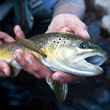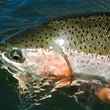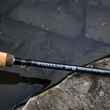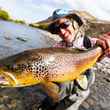Long, stringy probes drop down. A loud, gassy generator starts up. The jet boat’s captain applies throttle and the work begins. It’s a frenzied few minutes of fish going belly up while electricity streaming into the water stuns them long enough for quick capture.
One full net after another empties into the tub in the middle of the boat. Spawning rainbows, native cutthroats, pucker-lipped whitefish and predatory browns stewing together in the after shock.
The research crew only wants brown trout. Ten of them. But in the rush, other fish come on board. Bows, cutts and whiteys go back in the river. The browns are knocked out and thrown in a cooler. They’ve had their last meal and biologists want to know what it was.
“We know they eat a lot of fish,” says Bret High, Idaho Department of Fish and Game fisheries biologist. “In some places across the West, there have been problems with brown trout taking over rivers. We are interested in how many trout brown trout eat.”
More specifically, how many native Yellowstone cutthroat trout are eaten by brown trout. Browns aren’t native. Cutts are, so they have priority. Idaho’s South Fork of the Snake is managed for cutthroats. Rainbow harvest is encouraged because bows spawn with cutts. Browns don’t do that. They’re fall spawners. But they do eat. A lot. And brown trout populations are on the uptick in the West. Filling more brown bellies is going to take more fish.
“They certainly do have the capability of displacing other fish species and changing the dynamics of the river,” High says. “It’s concerning. It’s something we need to keep our eye on, but it’s not a problem yet.”
That’s why he only needs 10 fish per month. Knowing what’s in fish stomachs helps fishery managers determine the number of cutts being consumed. Bradley Stokes is in charge of the diet tally.
“It’s one of those things that is an acquired taste,” says Stokes, Idaho Department of Fish and Game fisheries intern. “You want to work quick so it doesn’t start to stink while you’re trying to figure out what’s going on.”
Stokes is in the lab hovering over a microscope. Three white fish pop out of the brown’s belly displayed under magnified view. A wad of insects is revealed next: stoneflies, mayflies and caddis. Sculpin and snails spill out too, but no cutthroat trout. Not in this brown or the majority of the other browns harvested in the last year. In a total of 75 fish, only two had cutthroat trout in their food bank.
“You want to go into it saying, ‘We don’t know what’s going to happen, keep an open mind.’ But browns are known as river sharks and they eat a lot of fish,” Stokes says. “The fact that only three percent of the browns ate cutts was really surprising. It think that’s great. I’m really excited about that.”

Initial results show cutthroat don’t rank high on the menu, but there’s more to the research. More than half of the browns were digesting stoneflies. No wonder anglers like chucking those. And out of the 998 items found in the fish, 444 were caddis flies. One brown trout alone had 140 caddis in its gut. Add more caddis to your box.
Browns might not be spawning with cutts, or eating cutts, but they’re butting in front of them in the feeding lane and that’s worth monitoring.
“People love to catch them. I love to catch them,” High says. “Browns are a great fish and they certainly have their place. We like them here as long as we can have our pie and eat it too.”































Comments
DanTheSwissman replied on Permalink
Whereas we here in Switzerland are concerned, that "your Rainbows" are eating our Browns... Ironic
stefano replied on Permalink
Seems Biologist really do`nt know whats going on with Browns , But the Browns do. be a shame to destroy Browns when they are not the Villian they are made out to be.
Toner Mitchell replied on Permalink
It seems hasty to draw broad conclusions without factoring in the percentage composition of the potential prey base. What is the operative reality here, that browns ate fewer cutthroats than expected, or how many cutthroats were available to be eaten? I guess it's a stream by stream thing. In some small streams, prey diversity is much lower, putting browns and cutthroats in more direct conflict. In New Mexico, we're seeing browns advance pretty fast. I caught a seven inch brown last year with a four incher down its throat. We're seeing 18 inch browns at 12,000 foot altitudes in some cutthroat drainages.
Pages